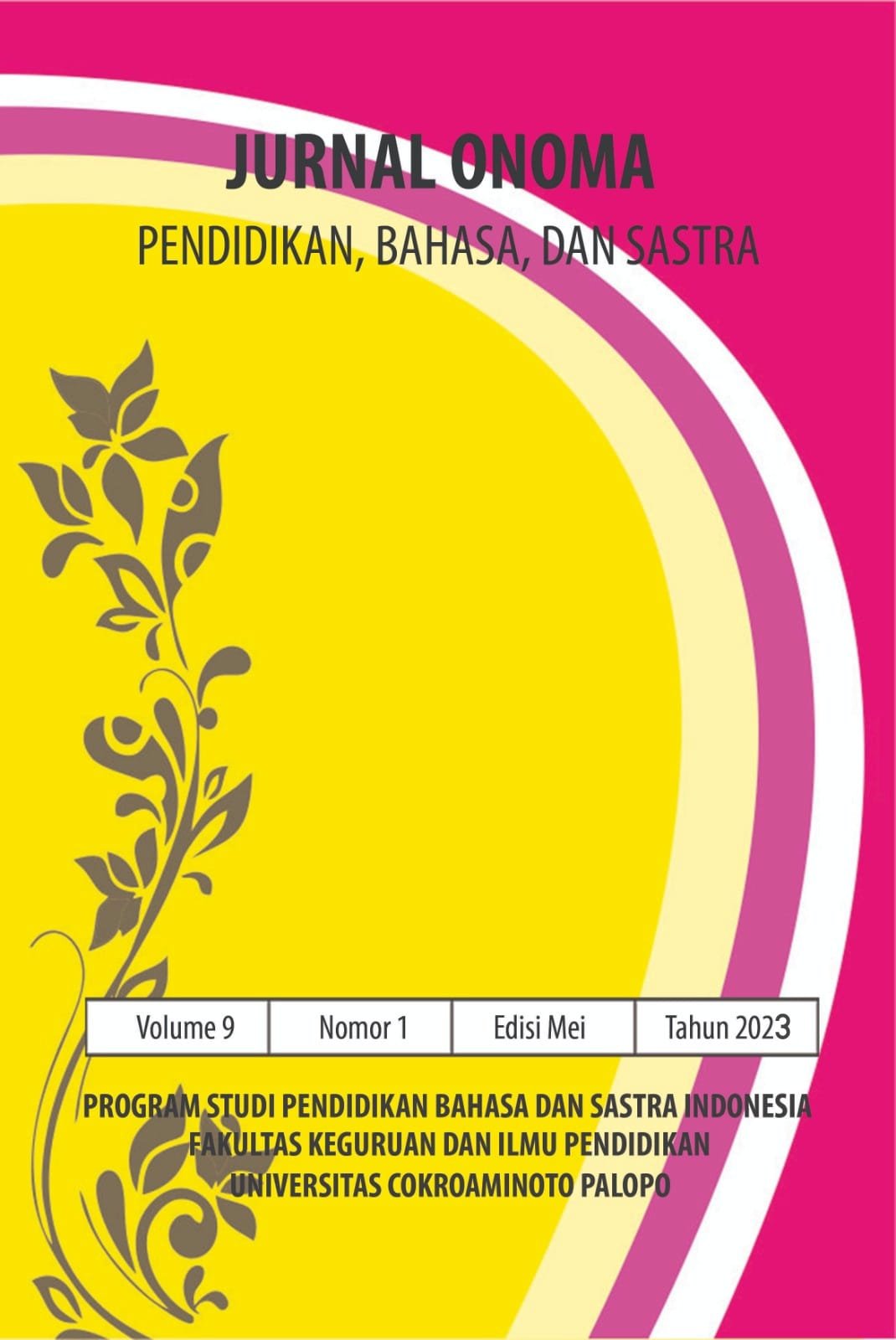Word Formation Processes Found on Shopee Live Streaming
https://doi.org/10.30605/onoma.v9i1.2177
Keywords:
Morphology; Word formation process; Shopee Live StreamingAbstract
Language is always developing and changing. It can be marked by the emergence of new words or new terms that come from various ways. A very striking development of new terms occurred in the field of commerce. Sellers often choose unique or catchy terms or words to entice buyers to join their live stream. With limited words they can type as their live Shopee title, sellers focus on communicating effectively and efficiently. This study aims to analyze several types of word formation processes found on Shopee Live streaming following the theory from Yule (2006). This research is expected to increase understanding of the word formation process contained in Shopee Live streaming. This research method is descriptive qualitative. Data were taken from written texts; such as titles that appear on Shopee Live Streaming and those performed by different Shopee sellers and then they were analyzed in the form of essays. The texts to be analyzed appear on the top left of the buyer's screen while the streaming is in progress. The findings showed that there were 219 words with a variety of formation processes. Borrowing, which involved 131 data, was the most dominant type used by the sellers. By this research, it is hoped that it can explore something that is developing in the community regarding the phenomenon of the use of new words or the mixing of words from Indonesian with English or with local languages, especially on online marketplace.
Downloads
References
Buier, L. (2002). English word formation. Cambridge University Press. DOI: https://doi.org/10.1017/9781316423530.020
Crystal, D. (2003). The Cambridge Encyclopedia of the English Language. Cambridge
University Press.
Dornyei, Z. (2007). Research methods in applied Linguistics. Oxford: Oxford University
Press.
Irfan, M. (2017). Machine translation. Retrieved from
https://www.researchgate.net/publication/320730405_Machine_Translation
Faradisa, A., Aziz, Z. A., & Yasin, B. (2019). An analysis of word formation processes found
in Instagram. Research in English and Education (READ), 4(2), 52-64.
Haspelmath, M. (2011). The indeterminacy of word segmentation and the nature of
morphology and syntax. Folia Linguistica. 45 (1). doi:10.1515/flin.2011.002. ISSN 0165-4004. S2CID 62789916. DOI: https://doi.org/10.1515/flin.2011.002
Jackendoff, R. (2012) . A user's guide to thought and meaning. Oxford University press
Liu, F. (2021, February 28). Livestream ecommerce: What we can learn from China.
Suparman, S., & Charmilasari, C. (2017). Analysis of Phase Structure Realization in Classroom Discourse: A Study of Systemic Functional Linguistics. Ethical Lingua: Journal of Language Teaching and Literature, 4(2), 120-126. DOI: https://doi.org/10.30605/ethicallingua.v4i2.624
Retrieved December 22, 2021, from https://www.nngroup.com/articles/livestream-ecommerce-china/
Given, L., M. (2008). The SAGE encyclopedia of qualitative research methods. California: DOI: https://doi.org/10.4135/9781412963909
SAGE Publications, Inc.
Miles, M. B., Huberman, A. M., & Saldana, J. (2018). Qualitative Data Analysis:
A Methods Sourcebook. California: SAGE Publications.
Millah, S. (2019, June 07). Ada Shopee Live, jualan online bisa lewat streaming. Retrieved
November 18, 2021, from Bisnis.com: https://teknologi.bisnis.com/read/20190607/266/931626/ada-shopee-live-jualan
online-bisa-lewat-streaming
Parse, R. R., & for Nursing, N. L. (2001). Qualitative Inquiry: The Path of Sciencing.
Burlington: Jones & Bartlett Learning, LLC.
Poedjosoedarmo, S. (2006). Perubahan tata bahasa: Penyebab, proses, dan
akibatnya. Yogyakarta: Universitas Sanata Dharma.
Ramadhani, F. (n.d.). Ini 5 faktor pesatnya perkembangan e-commerce di Indonesia.
Suparman, S. (2014). Prosesi Ritual Pascapemakaman Masyarakat Tangru Kecamatan Malua Kabupaten Enrekang. Prosiding, 1(1), 163-167.
Retrieved November 18, 2021, from Compas: https://compas.co.id/article/perkembangan-e-commerce/
Riyanto, G. P. (2019, May 10). Daftar 10 marketplace online paling ramai pengunjung di
Asia Tenggara. Retrieved November 18, 2021, from Kompas.com: https://tekno.kompas.com/read/2021/05/10/15270037/daftar-10-marketplace-online-paling-ramai-pengunjung-di-asia-tenggara?page=all
Rosa, R. N., & Zaim, M. (2014). Shift in word formation process of Indonesian words. SELT,
-378.
Sari, S. W., & Martiwi, R. (2020). Blending construction in English foods and beverages in
Indonesia: Linguistics and cultural views. Wanastra: Jurnal Bahasa dan Sastra, 12(2), 278-287.
Shan, W. & Norm, A. (2007). Electronic Marketplace Definition and Classification:
Literature Review and Clarifications. Enterprise Information Systems, 89-112.
Yule, G.(2006). The study of Language. 3rd Edition. Cambridge University Press.
Downloads
Published
How to Cite
License
In submitting the manuscript to the journal, the authors certify that:
- They are authorized by their co-authors to enter into these arrangements.
- The work described has not been formally published before, except in the form of an abstract or as part of a published lecture, review, thesis, or overlay journal.
- That it is not under consideration for publication elsewhere,
- That its publication has been approved by all the author(s) and by the responsible authorities – tacitly or explicitly – of the institutes where the work has been carried out.
- They secure the right to reproduce any material that has already been published or copyrighted elsewhere.
- They agree to the following license and copyright agreement.
License and Copyright Agreement
Authors who publish with Onoma Journal: Education, Languages??, and Literature agree to the following terms:
- Authors retain copyright and grant the journal right of first publication with the work simultaneously licensed under Creative Commons Attribution License (CC BY 4.0) that allows others to share the work with an acknowledgment of the work's authorship and initial publication in this journal.
- Authors are able to enter into separate, additional contractual arrangements for the non-exclusive distribution of the journal's published version of the work (e.g., post it to an institutional repository or publish it in a book), with an acknowledgment of its initial publication in this journal.
- Authors are permitted and encouraged to post their work online (e.g., in institutional repositories or on their website) prior to and during the submission process, as it can lead to productive exchanges, as well as earlier and greater citation of published work.

















